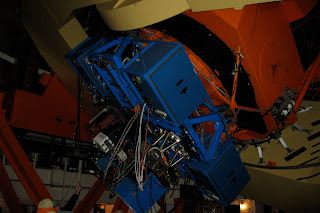
The main event on Monday, January 18 was a sunset visit to the twin 10 meter diameter Keck Telescopes at the 13,796 foot peak of Mauna Kea.
But first, we had another lecture, Cosmology. It was a continuation of where we left off the day before and covered some of the following. Gamma ray bursts, short lived beams of very intense gamma rays that are thought to occur when a high mass star collapses in a supernova event to become a black hole. Hubble's Law, v = Hd, where v is the velocity of a galaxy, H is the Hubble constant, and d is the distance to the galaxy. And the Cosmological Constant which is the energy associated with empty space. It is due to electron-positron pairs being created, repelling, and annihilating. After lunch we left the hotel.
The group rode in two four wheel drive vehicles, Ford E-350 small buses with heavy duty brakes. On top of the mountain the air is so thin that regular disk brakes do not work, they overheat. So coming down the drivers split braking between the transmission and the brakes. We picked up dinner and headed out on Saddle Road. So named because it is on the saddle between Mauna Loa and Mauna Kea. We passed the Military Reservation and did not hear any explosions. (Which we were told sometimes seem timed to occur when vehicles are passing.) We stopped at the 9,000 foot level where the astronomers live for a lecture and hot picnic dinner. We spent some time here to become acclimated to the altitude. Then we proceeded up the side of Mauna Kea. The road was paved up to 9,200 feet; then there was an unpaved washboard stretch, described as like driving on Mars, up to 13,000 feet; and then the final section was paved.

At the summit we were told, take your time, move slowly, avoid exertion, breathe deeply. There was 40% of the oxygen that there is at sea level. It was so dry, that even though the temperature was below freezing, our exhaled breath was not visible. In the picture to the right, below the dome, you can see our two buses and an emergency evacuation vehicle (in case someone suffers from altitude sickness near 13,796 feet). One of our guides pointed out a terminal moraine deposited by an ice age glacier, near the top of the volcano! It was interesting to see that our two guides merged into our group. We were going inside the telescope domes, something they don't normally get to do. The air inside the domes is air conditioned during the day, so that when the domes are opened at night changes in size or shape due to changing air temperature are minimized.
Each of the two telescopes has a ten meter (33 feet) diameter primary mirror. It is made of 36 hexagonal shaped sections to cut down on weight. Each section can be aimed independently. Here are pictures of the primary mirror from the back and from the side. In the side view, supports behind the mirror are painted white and supports in front are black.


Below is a picture of the secondary mirror. There is something very interesting in this picture. Notice that all the supports are round pipes; except for one. In the lower left, the second one up is hexagonal in cross-section. It is part of the adaptive optics system (described below).


A laser excites sodium atoms above what little atmosphere there is at this altitude creating an artificial star. This can be used to determine what the atmospheric distortion is at any moment. Then the shape of a deformable adaptive optics mirror is constantly changed to compensate for air turbulence. With this recent improvement the Keck telescopes can take pictures of better quality than the Hubble Space Telescope. Here is a picture of the control room.

The scientist using the telescope was in Toledo, Ohio. Here are duplicate screens showing what was on the experimenter's monitors.

Here is a picture of the rear of the detector.

Here is a picture of the side of the detector.

A system of mirrors is being set up so that the two telescopes can work together as an interferometer. The telescopes are 85 meters (279 feet) apart. The result will give the angular resolution of an 85 meter diameter telescope.
At the end we went outside. I've never seen Mars so red. I felt a little light-headed, a little tired. No one needed the emergency evacuation vehicle. We went down to 9,000 feet for some star-gazing before returning to our hotel.
The Keck Observatory is a world leading, state-of-the-art telescope facility observing in the optical and near-infrared wave-lengths. It has been real neat to be up close.
On the agenda for tomorrow, a whale watching cruise.